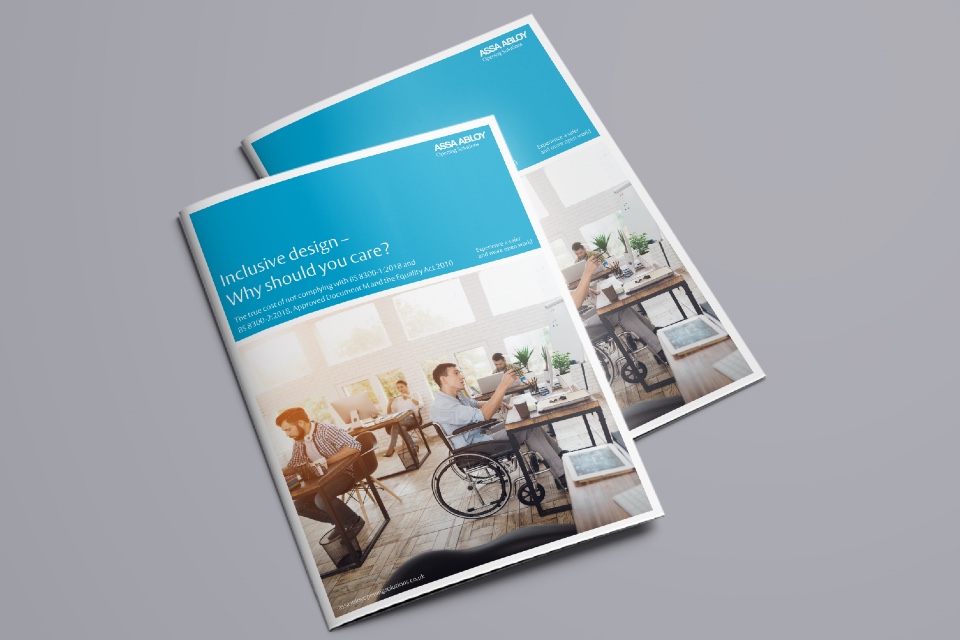ASSA ABLOY Opening Solutions UK & Ireland has published a free white paper for building owners, developers and facilities managers of retail buildings, offering best practice advice on the guidelines governing inclusive design and the risks of not complying with these.
When talking about inclusive design, many people immediately think of those with a disability or specific, specialist requirements.
While inclusive design encompasses the needs of these people, its key objective is to make a site inclusive for all, no matter what. In fact, despite public perception and the wheelchair being the symbol for accessibility, less than 8 per cent of disabilities require the use of a wheelchair[1].
Whether it’s the elderly, disabled or children, everyone should be able to access and use a building and its facilities easily and safely.
However, evidence across the building industry suggests there is still a great deal of confusion and non-compliance surrounding the guidance governing inclusive design. This includes Approved Document M, the Equality Act 2010 and, crucially, BS 8300-1 and 8300-2:2018, which sets out how buildings should be designed, constructed and maintained to create an accessible and inclusive environment for all. It applies to both new builds and refurbishments.
As a result, the white paper seeks to offer clear advice on why building owners, developers and facilities managers should be demanding building solutions that adhere to these standards.
Not only should people be able to access and use a building and its facilities easily, comfortably and independently, but key market drivers – such as an ageing population and consumer buying power – mean those that do not prioritise inclusive design will face ever-increasing challenges that damage brand reputation and could lead to costly legal disputes.
The white paper covers what the guidelines governing inclusive design state, as well as providing a detailed overview of the considerations for door opening solutions.
In addition, while fire safety has always been critical, incidents such as the Grenfell tragedy have highlighted how this issue cannot afford to be an afterthought in buildings. Therefore, the white paper includes how to specify door opening solutions that not only meet the requirements outlined in the guidelines for inclusive design, but how to ensure these meet the necessary fire safety standards too.
“Ultimately, there is a duty of care to make sure an environment is inclusive to all,” explained Eryl Jones, Managing Director of the ASSA ABLOY Door Hardware Group. “Whether it’s accessing an environment or ensuring individuals are able to safely exit a building in the event of a fire or other emergency, the importance of solutions that prioritise inclusive design cannot be overestimated.
“The UK government states that by 2037, those over 65 will account for nearly a quarter of the population. It also says that 6% of children, 16% of working adults and 45% of adults over state pension age are disabled, with disabilities that affect mobility, lifting and carrying being the most commonly reported. Our buildings need to be designed to meet the needs of everyone, and choosing the right door opening solution is critical to this.
“By not creating an inclusive environment, the impact on consumer spending and brand reputation is significant, too. Research from disability charity Purple found that businesses are losing approximately £2 billion a month by ignoring the needs of disabled people. The ‘grey pound’ also accounts for £320 billion of annual household spending, with the over-50s holding over three-quarters of the nation’s financial wealth. As a result, the fallout of building design that does not place inclusivity at its heart is clear to see.
“Rather than simply considering what the legal requirements around inclusive design are, building owners, developers and facilities managers should instead be looking at this as a real opportunity. The benefits include greater consumer loyalty and spending opportunities, as well as increased differentiation, credibility and brand awareness. Our new white paper aims to demystify what the guidelines governing inclusive design state, while making clear why this is an issue that those responsible for retail buildings should care about.”
Douglas Masterson, Technical Manager at the Guild of Architectural Ironmongers (GAI), added: “It is refreshing in the current climate to see accessibility being placed firmly on the agenda through this white paper. At the moment, the headlines are rightly dominated by fire safety – following the Grenfell tragedy – and on-going issues related to the Covid-19 pandemic. While these are of huge importance, accessibility must always have room in any discussion relating to the construction industry.
“This paper states: ‘All those involved in the design and construction of a building should not simply be working towards inclusivity but demanding it every single time.’ The GAI is firmly in favour of this statement, and the correct specification of hardware in a building must have the issues of accessibility and inclusive design at its heart.”
Bob Perry, CEO of the Door Hardware Federation (DHF), comments: “It’s really good to see such an important message being highlighted in this white paper. Our society is changing – both in its demographics and its attitudes – and it is clear that any company that fails on inclusivity will be left behind. At the same time, however, the requirements around inclusive design are somewhat opaque and there is still much confusion in the industry.
“What this white paper from ASSA ABLOY does is present everything the industry needs to know about the issue. It outlines the relevant standards, explains what they really mean, and tells them exactly what they need to do to make sure their door hardware is compliant. On behalf of the DHF, I recommend that it is essential reading.”
To download the white paper for free, please visit www.assaabloyopeningsolutions.co.uk/inclusivedesign






